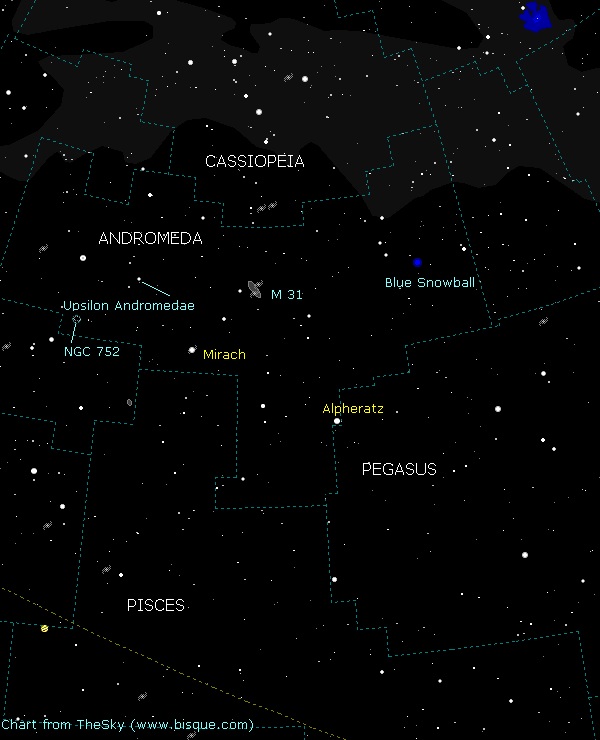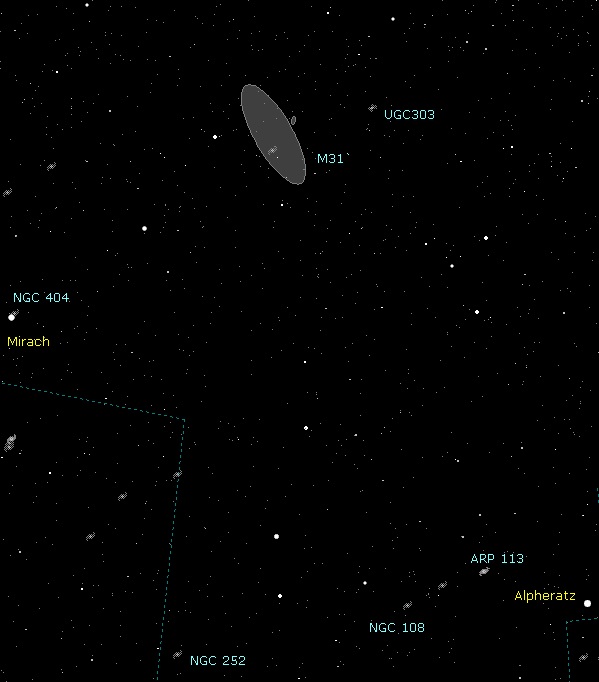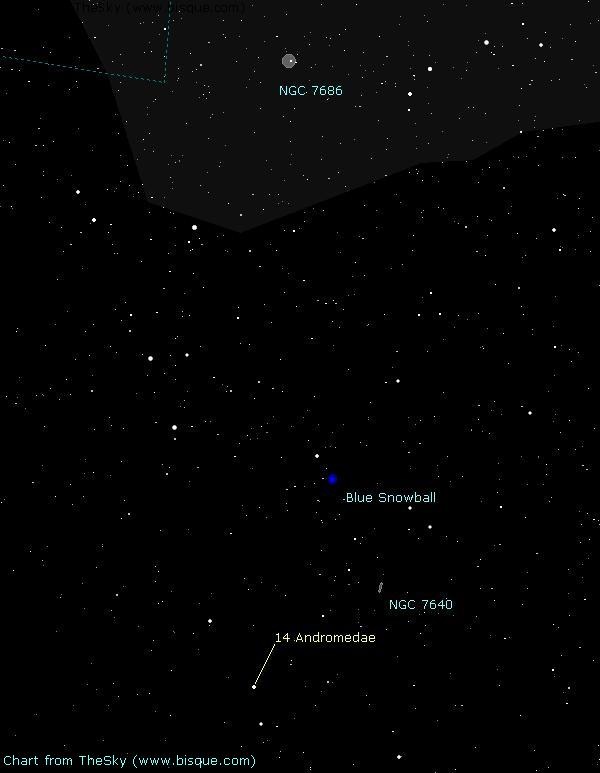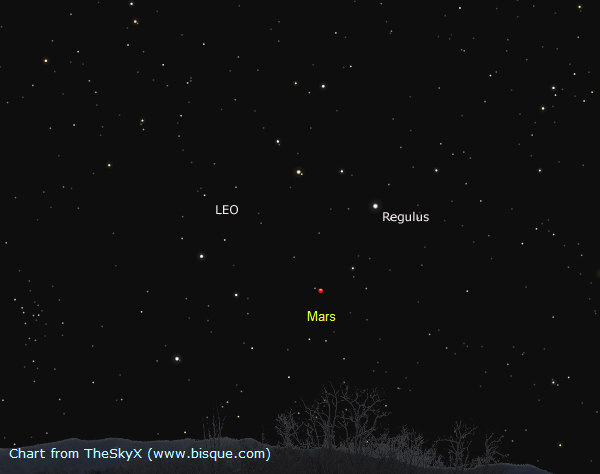The Fair Maiden - Andromeda
Whenever the name Andromeda arises in conversation or in print, we immediately visualize a majestic galaxy. The Andromeda Galaxy, aka M31, is located a mere 2.9 million light-years - down the cosmic highway. This island of an estimated 400 billion stars can even be spotted naked eye from dark locations. M31 is flanked by two smaller galaxies known as M32 and M110. Mythology depicts Andromeda as the daughter of King Cepheus and Queen Cassiopeia and was sacrificed to the sea monster Cetus, but Perseus saved the day.
The constellation itself measures 722 square degrees of sky and ranks 19th in area. Andromeda is now well placed high in the pre-winter skies and with M31 located at almost 42 degrees in declination, it is almost overhead. One should take advantage of clear nights to look at the most observed and imaged galaxy seen in the northern hemisphere. Readers with moderate to large instruments can try to spot the many globular clusters that reside in our galactic neighbour.

Andromeda’s alpha star is named Alpheratz; a blue B-class star that is the brightest member of an odd class of "mercury-manganese" stars. This magnitude 3.5 sun has a surface temperature of 13,000 Kelvins is only one of two examples of a star being referred to in two constellations. It also forms the northeastern corner of the square of Pegasus. The other example is Elnath which links Taurus to Auriga. Alpheratz is a spectroscopic binary with its companion being so close; they orbit each other in only 96 days. Alpheratz resides 97 light-years from us.
At literally the other end of the spectrum, Mirach (Beta Andromedae) is a red giant star with a cooler surface measuring only 3,800 Kelvins. Mirach lies 200 light-years away and if it replaced our Sun, it would measure out to the orbit of Mercury. It does have a very dim 14th magnitude companion. From Mirach, the companion would shine like a bright red Venus, whereas from the companion, Mirach would sear the sky 120 times more brightly than our full Moon. Before leaving Mirach, be sure to look seven arc minutes to the north for NGC 404. Also referred as Mirach’s Ghost, NGC 404 is a 10th magnitude elliptical galaxy residing about 10 million light-years from us. The key to viewing NGC 404 is to keep brilliant Mirach (magnitude 2.3) out of the field of view.

Our next target is the Blue Snowball located in the western section of the constellation. Catalogued as NGC 7662, this planetary nebula is thought to be some 5,000 light-years away. Its outer shell of gas measures 50,000 astronomical units wide or lining up 833 of our solar systems end to end. Observing this object in an eyepiece, you will immediately see it is smaller than the famous Ring Nebula and takes on a striking blue much like the planet Neptune. The Snowball reveals itself better in larger scopes but no matter what scope you choose, it is a must for your observing list.
Now here comes a real challenge. Go back to Alpheratz and move two and a third degrees east. From a dark location, you should locate Galaxy Cluster VV-166 or Arp 113. No less than eight galaxies occupy this area and range from magnitude 13.4 to 16.0. The cluster members are NGC 67, 67a, 68, 69, 70, 71, 72 and 72a with the entire cluster being an estimated 350 million light-years away. Good luck with this challenge.
If open clusters suit your needs, look for NGC 7686. This magnitude 5.6 cluster consists of a loose concentration of stars with two bright stars being the most obvious. NGC 7686 can be found six and a half degrees north of the Blue Snowball. We then have NGC 752 that has a healthy population of about 60 suns. This old cluster possesses an extremely hot star spectral class A2 star which indicates NGC 752 might be more than a billion years old. This cluster measures 60 arc minutes wide or twice the full moon’s width and is 1,300 light-years away. NGC 752 also goes by the name Caldwell 28.
To date, ten extrasolar planets call this constellation home. Upsilon Andromedae is a main-sequence star like our Sun. It is only 52 ly away and has three planets around it. Another parent star is 14 Andromedae. At 258 light-years from us, astronomers believe this could be a variable star. Although it is now orange in colour, it might have been white or yellow-white dwarf in its younger days. This orbiting planet is one of the few to be associated with an evolved star. 14 Andromedae b circles the mother planet in half an earth year and has a mass of 4.8 Jupiters.

Comet C/2009 P1 Garradd is getting brighter as it slides through the constellation Hercules. But Hercules is now low in the west thus making the comet difficult to observe. In a few weeks, it will shift over to morning skies before sunrise. The comet will reach a minimum solar elongation of 45 degrees on December 5 with a perihelion date of December 23. Another Kodak moment comes on the nights of Feb 3 and 4 as the Comet Garradd slides by the globular cluster M92.
The Geminids is one of the best meteor showers of the year if you can stand the cold. This year the ongoing stream of shooting stars will occur on nights of December 13 and 14. Meteor showers, in general, are the direct result of dust and particles from passing comets that linger in space until Earth plows through the cloud of debris. This comet stuff entirely burns up about 100 kilometres high with no danger of hitting the ground. The average size is these particles would be the size of the period at the end of this sentence or smaller. The parent object responsible for the Geminids shower is an asteroid named 3200 Phaethon. This show produced a generous 120 meteors per hour that slowly perish in the atmospheric friction. These (slow) moving entries are striking the atmosphere at only 35 km/sec compared to the fast-moving Perseid shower in August at 72 km/sec. You will have to deal with a bright moon that was full on the 10th.
Our solar system planets are always a gem to observe and photograph. Venus is low in the west after sunset and is south of the globular cluster M22 on December 2nd. Jupiter, on the other hand, is well up at sunset but is retreating from us. In fact, it becomes stationary on the 26th thus halting its western movement against the stars known at retrograde. After this date, it continues its normal easterly dance amongst the stars.
The red planet Mars is still 198 million kilometres from us but is approaching at about 15 km/sec. it is presently in the constellation Leo and can be found 10 degrees east of Bright Regulus. Saturn and her majestic rings now rise at 3:30 local time. In fact, Saturn and the star Spica to its right, peek over the eastern horizon at the same time and climb together. Tiny Mercury will climb to its highest point at 22 degrees in the eastern sky on the 26th.

The last total lunar eclipse for Canada till October 2014 will occur on the morning of the 10th. A lunar eclipse is very safe to watch and photograph as the natural full moon darkens in the earth’s shadow. A solar eclipse, on the other hand, requires extreme caution. This entire eclipse favours the western side of North America. As you move further east, partial phases will be witnessed at moonset. Totality occurs at 6:32 a.m. Pacific Time. New moon is listed for the 24th at 13:06 est and starts lunation 1101. I hope it is not too cold in your area as the Winter Solstice officially begins on December 22nd at 00:36 est.
And finally, a word on Christmas presents for the budding astronomer. If in doubt on what kind of scope to purchase for that special someone, contact your closest telescope store or ask any centre or club member on guidance. Big box stores are great for everyday items but unfortunately sell very low-end telescopes and sales staff know nothing about the product.
Have a very Merry Christmas and Happy Holidays to everyone. Until next month, clear skies everyone.
